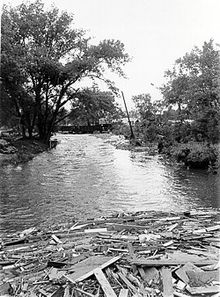 Debris along Rapid Creek after the flood | |
| Meteorological history | |
|---|---|
| Duration | June 9–10, 1972 |
| Overall effects | |
| Fatalities | 238 |
| Damage | $67.5 million (1972 USD) |
| Areas affected | Rapid City, South Dakota area |
The Black Hills Flood of 1972, also known as the Rapid City Flood, was the most detrimental flood in South Dakota history, and one of the deadliest floods in U.S. history. The flood took place on June 9–10, 1972[1] in the Black Hills of Western South Dakota. 15 inches (380 mm) of rain in a small area over the Black Hills caused Rapid Creek and other waterways to overflow. Severe flooding of residential and commercial properties in Rapid City occurred when Canyon Lake Dam became clogged with debris and failed in the late evening hours of June 9 resulting in 238 deaths and 3,057 injuries.[2] Over 1,335 homes and 5,000 automobiles were destroyed. The value of property damage was estimated to be over US$160 million in 1972 dollars ($1.17 billion in 2023 dollars[3]). Flooding also occurred in Battle, Spring, Bear Butte, and Boxelder creeks.[4]
- ^ Cite error: The named reference
NHP1753was invoked but never defined (see the help page). - ^ "The 1972 Black Hills-Rapid City Flood Revisited". United States Geological Survey. Archived from the original on October 9, 2007. Retrieved October 15, 2007.
- ^ 1634–1699: McCusker, J. J. (1997). How Much Is That in Real Money? A Historical Price Index for Use as a Deflator of Money Values in the Economy of the United States: Addenda et Corrigenda (PDF). American Antiquarian Society. 1700–1799: McCusker, J. J. (1992). How Much Is That in Real Money? A Historical Price Index for Use as a Deflator of Money Values in the Economy of the United States (PDF). American Antiquarian Society. 1800–present: Federal Reserve Bank of Minneapolis. "Consumer Price Index (estimate) 1800–". Retrieved February 29, 2024.
- ^ Cite error: The named reference
CWTwas invoked but never defined (see the help page).